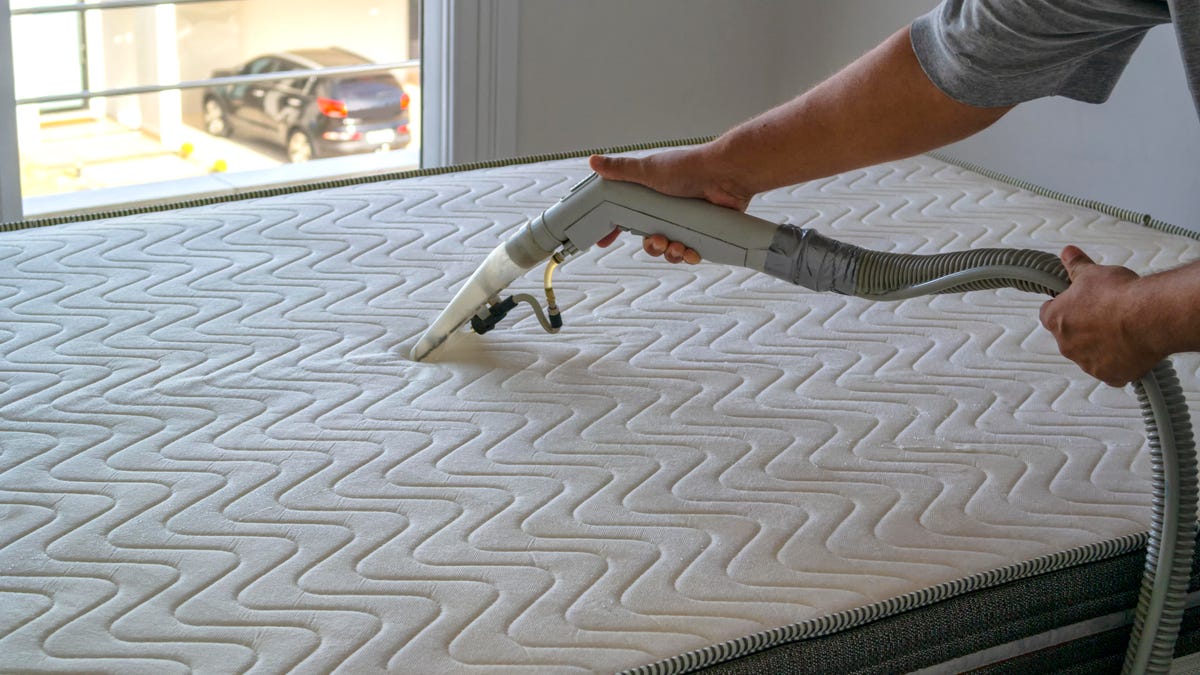How to clean a mattress: 6 simple tips
When's the last time you cleaned your bed? Use these tips to learn how to get stains out of a mattress, the type of bed cleaner to use and more.

It's possible you've never cleaned a mattress -- and don't worry, you wouldn't be alone. Lots of folks just wash their sheets and bedding every week or two, thinking that's good enough. But once you find out what could be in your mattress, you'll probably reconsider. While it's a myth that mattresses double their weight every 10 years in dust and dead skin cells, they do accumulate quite a bit of debris over time.
Human beings lose millions of skin cells every hour (yep, that's millions -- an hour), and they don't all stay on the outer surface of your bed. On top of that, there are bacteria, dust, hair and dust mites, plus dead mites and mite excrement in the mix, too. Not only is this icky, but it can also exacerbate symptoms for anyone suffering from allergies, asthma or other breathing difficulties. That's why it's best to clean your mattress about twice a year or once every six months (and replace it every six to eight years).
Ready to clean that dirty mattress yet? Follow the steps and tips below to get it done right, using tools you probably have around the house already that can double as bed cleaner.
Strip your bed
First things first: Strip your bed of all its bedding, including the sheets, pillows, comforter and mattress pad. Throw them all into the washer on the hottest setting possible (of course, check labels on everything to make sure this won't damage any of your bedding first), then dry them on the hottest possible dryer setting also. Pillows may not need to go in the machine every time, but give them a good washing about four times a year if their label care instructions allow.
How to get stains out of a mattress
- Spot clean any stains that may be on your mattress. This can be done with a few spritzes of diluted dish soap, gentle laundry detergent, vinegar, hydrogen peroxide or an enzyme cleaner mixed with cold water in a spray bottle. One easy mixture you can make at home contains one part white vinegar, four parts cold water and an optional 10 to 20 drops of your favorite essential oil.
- Once you've applied your cleaning solution, let it sit on the stains for around 10 minutes (or leave it on longer for worse stains, up to 30 minutes)
- Gently blot with a clean cloth.
- Once most of the stains are gone, apply cold water to another clean cloth and continue blotting. Always be sure to blot the stains, rather than scrubbing them. Scrubbing or being too rough can make things worse and help to set the stain you're trying to remove.
White vinegar and baking soda are simple household items you can use to clean your mattress.
Sprinkle baking soda
Once your spot-cleaned areas are mostly dry, you can start sprinkling baking soda on your mattress. You can use up to an entire 1-pound box on it if desired. Leave it overnight, for a full 24 hours if at all possible, and then vacuum it up.
Baking soda isn't the only way to freshen up your mattress. If it's sunny outside and your mattress is easy enough to move, you can let your mattress soak in some sunshine and fresh air for a few hours of natural brightening and effortless stain removal.
Vacuum your mattress
For most mattresses, regular vacuum cleaners with the upholstery attachment in place should work just fine. According to HGTV, a HEPA-rated vacuum is ideal if you want the strongest suction possible to suck up all that debris hidden deep in your mattress.
If you have a memory foam mattress, however, choose the softest, gentlest attachment you have available to prevent damage to the cover material. Use circular motions when vacuuming to remove even the most set-in particles. Be sure to go over the seams and other nooks and crannies at least a couple of times, because that's where the worst of the worst gunk tends to gather.
What if you want a deeper clean?
If you've had a doozy of a spill or a little one had an accident in their sleep, you may want a deep clean mattress. Consider opting for a shampooer, though this isn't recommended on some types of mattresses, like memory foam or pillow top varieties. (Keep this in mind when mattress shopping for each member of the family.)
There are also companies that will deep clean your mattress for you professionally, or you can try to do it yourself. Experienced DIYers say that steam cleaners or even garment cleaners work well on most mattresses, and that especially delicate surfaces call for more creative nonmechanized cleaning methods, such as covering the mattress with a layer of unscented kitty litter overnight to draw out any lingering odors or moisture. When in doubt, contact customer service at the manufacturer's website for advice.
Keep in mind
If you have a two-sided flippable mattress, you'll want to flip it every three months and clean both sides the same way. There aren't too many mattresses made that way currently, as most are set up in layers to remain on one side only. In this case, be sure to rotate the mattress end to end every few months regardless of your cleaning cycle. Sometimes, it's only the top of the mattress that needs to be flipped or rotated. Again, if you're unsure about your particular mattress, contact the manufacturer for advice.

